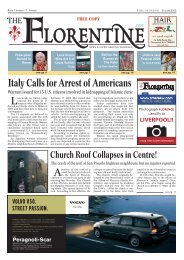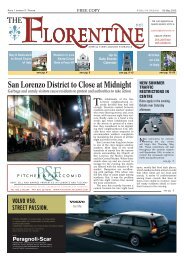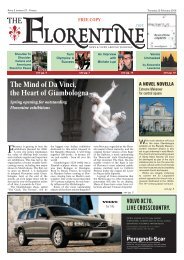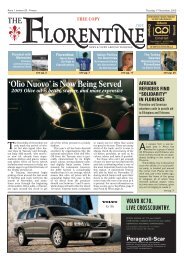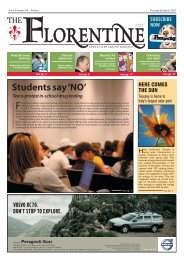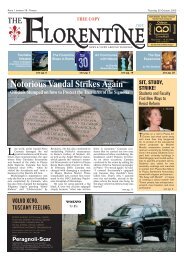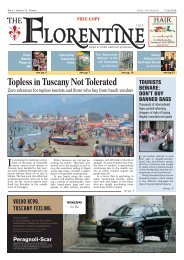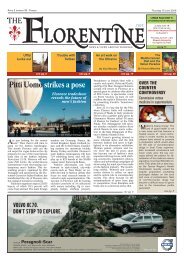Italy's favourite son, finally moving out - The Florentine
Italy's favourite son, finally moving out - The Florentine
Italy's favourite son, finally moving out - The Florentine
You also want an ePaper? Increase the reach of your titles
YUMPU automatically turns print PDFs into web optimized ePapers that Google loves.
18<br />
Thursday 7 September 2006<br />
Travel & LEISURE<br />
Life in Italy<br />
www.theflorentine.net<br />
SLOW TRAVEL along the highways and byways of Italy<br />
When the hills were alive with the sound of quarrymen<br />
by Sabine Eiche<br />
Photo by sabine Eiche<br />
Nanni di Banco, Orsanmichele tabernacle<br />
Has it ever occurred to you<br />
that the stony city of Florence<br />
was literally carved<br />
<strong>out</strong> of the surrounding hills? It’s<br />
quite true. Countless local quarries<br />
provided the blocks of stone for the<br />
walls of medieval and Renaissance<br />
churches and palaces, and for the<br />
columns and architectural ornaments<br />
to decorate them. Pietraforte, a<br />
kind of light brown limestone, came<br />
from quarries at Costa San Giorgio, in the Boboli<br />
hill between Santa Felicità and Porta Romana,<br />
at Bellosguardo, and around Marignolle and Le<br />
Campore, all s<strong>out</strong>h of the Arno. To the north, the<br />
hills of Fiesole, Maiano and Settignano provided<br />
the blueish-grey sandstone pietra serena.<br />
In the 13 th century, load after load of pietraforte<br />
was hauled over the Arno to the <strong>out</strong>skirts<br />
of Florence to construct the enormous basilicas<br />
of Santa Maria Novella and Santa Croce. Even<br />
the piers inside these two churches are of pietraforte.<br />
Look at Palazzo Vecchio, the<br />
Loggia dei Lanzi, the Bargello and<br />
Orsanmichele, and you are looking<br />
at pieces of the s<strong>out</strong>hern hills<br />
transformed into architecture. <strong>The</strong><br />
gigantic blocks of rustication that<br />
you see on the façades of the 15 th -<br />
century Palazzo Medici were cut<br />
<strong>out</strong> of pietraforte quarries. Filippo<br />
Strozzi, whose palace rivals that of the Medici<br />
in size, had endless loads of stone brought from<br />
quarries at Boboli and Marignolle. It is said that<br />
between November 1495 and March 1497, Strozzi’s<br />
heavily-laden carts rattled over the Arno<br />
more than a thousand times. At Palazzo Pitti, the<br />
builders had it much easier, since their source<br />
(the Boboli hill) was right behind the palace. In<br />
fact, Palazzo Pitti sits on the hollowed <strong>out</strong> part of<br />
one of these quarries.<br />
If pietraforte was used mainly for the construction<br />
of walls, pietra serena was used above<br />
all for columns, stairs, doors and windows. <strong>The</strong><br />
oldest of these quarries, dating back to Etruscan<br />
times, were at Monte Ceceri in Fiesole, and they<br />
continued to be worked during the Roman and<br />
early medieval periods. <strong>The</strong> demand for pietra<br />
serena was so high that in the 13 th century new<br />
Piero di Cosimo, <strong>The</strong> Building of a Double Palace<br />
quarries had to be opened further east, around<br />
Vincigliata and Settignano. By the 15 th century,<br />
when Brunelleschi’s architectural style boosted<br />
the popularity of pietra serena to unprecedented<br />
heights, it was also being extracted at Golfolina,<br />
west of Florence.<br />
Brunelleschi chose quarries that would provide<br />
enormous blocks of pietra serena from which he<br />
could cut entire column shafts. He quarried the<br />
stone for the loggia of the Ospedale degli Innocenti<br />
at Trassinaia, near Vincigliata. <strong>The</strong> columns<br />
for San Lorenzo came from a site<br />
nearby, still known as the Cava<br />
delle Colonne.<br />
Vasari tells us that Michelangelo<br />
got the pietra serena for the<br />
New Sacristy and the Laurentian<br />
Library from a quarry in the valley<br />
of the Mensola, below Monte<br />
Ceceri. Because pietra serena does<br />
not weather well, it was normally reserved for<br />
the interior of buildings, although the portico of<br />
the Uffizi, entirely in pietra serena, is a significant<br />
exception. Vasari (who built the Uffizi) says<br />
that he chose a variety of pietra serena known<br />
as pietra del fossato, which was also used for<br />
the columns of the mid-16 th -century Mercato<br />
Nuovo (popularly called the Straw Market). Not<br />
much time passed before pietra serena became<br />
so sought after that the Grand Dukes of Tuscany<br />
decided to restrict access to the Fiesole quarries<br />
found between San Francesco and Fontelucente,<br />
and those at Mulinaccio below Maiano.<br />
By the early 20 th century, most quarries around<br />
Florence had closed. Probably the last <strong>Florentine</strong><br />
monument with stairs and columns carved <strong>out</strong><br />
of pietra serena was the Biblioteca Nazionale<br />
Centrale, begun in 1911. However, after the Second<br />
World War, one of the<br />
pietraforte quarries of Boboli<br />
was reopened, specifically to<br />
provide stone for the rebuilding<br />
of the bombed Ponte Santa<br />
Trinità.<br />
But even when they are<br />
abandoned, quarries are not<br />
forgotten. Some are commemorated<br />
in street names, such as<br />
the Vicolo della Cava, a tiny<br />
lane off the Costa San Giorgio that once led to a<br />
quarry above Boboli. Some survive because they’ve<br />
been put to other uses, such as the Cava delle Colonne,<br />
which John Temple Leader in the 19 th century<br />
turned into an artificial lake in his park at<br />
the Castello di Vincigliata. Maiano is the location<br />
of one of the best known abandoned quarries, a<br />
huge amphitheatre carved <strong>out</strong> of the hillside, now<br />
used by rock-climbers. Nearby, in a small building<br />
constructed for the use of the quarrymen by the<br />
same Temple Leader, is the renowned restaurant<br />
Cave di Maiano (055-59133, open daily for lunch<br />
and dinner). <strong>The</strong> fare is appropriately wholesome<br />
and very tasty. Eating <strong>out</strong> on the spacious terrace<br />
overlooking the hills on a balmy evening is a<br />
memorable experience.<br />
Many other quarries are preserved in the local<br />
memory and visited by excursionists, especially on<br />
the north side of the Arno. For the past two years,<br />
the group Anpilandia has organized a Sunday<br />
hike in May following the trails of the old quarrymen<br />
in Fiesole and Settignano (for information<br />
contact Consiglio di Quartiere 2, 055-2767841;<br />
or ask Sig.ra Rita at Trattoria Osvaldo at Ponte<br />
a Mensola, closed Tuesday and Wednesday, 055<br />
602168; while there, taste her wonderful farfalle<br />
al frantoio!).<br />
Sabine Eiche, a Canadian writer and art historian living<br />
in Florence, has published extensively on Italian<br />
Renaissance architecture, gardens and drawings. She<br />
is an authority on the history and culture of the Duchy<br />
of Urbino and is preparing a book ab<strong>out</strong> the local cuisine.<br />
Her most recent book is Presenting the Turkey:<br />
<strong>The</strong> Fabulous Story of a Flamboyant and Flavourful<br />
Bird. (http://members.shaw.ca/seiche).<br />
Florence<br />
SAM’ S<br />
Amsterdam<br />
MARKETS<br />
Try Sam’s for a bit of America !!<br />
Over 250 products imported by Sam’s from the USA<br />
SAM’S HAS IT !<br />
In the center of Florence near the Bargello Museum<br />
Via Ghibellina 117r. - Tel. 055-7189020<br />
Store hours: Mon-Sat 11.00 am – 7.00 pm<br />
www.samsmarkets.com




